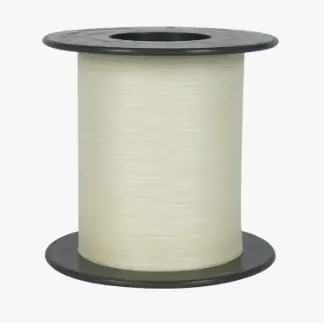As textiles continue to develop towards high added value and functionality, Metallic Yarn has gradually become an important player in the fashion and industrial fabric fields with its unique gloss effect, structural stability and diverse application value.
What is Metallic Yarn? Not Metal, But Better Than Metal
Metallic yarn is a decorative or functional yarn with a metallic appearance or metallic function, and is not entirely composed of metal. It is usually made by combining ultra-thin metal film, metal powder or metal sheet with a substrate such as polyester, nylon, polypropylene, etc., and then processed into a yarn form with textile properties. Common forms include Metallic Covered Yarn, Metallic Film Yarn and Metallic Blended Yarn.
Main Types and Structural Forms of Metallic Yarn
According to different manufacturing methods and uses, metallic yarns can be roughly divided into the following categories:
1. M-type yarn (Metallic Film Yarn)
It is made by combining a metal film (such as aluminum) and a polyester film through vacuum coating and then slitting. With bright appearance and rich colors, it is the most commonly used type in decorative textiles.
2. MX type yarn
Twisting nylon or polyester filaments on the outer layer of M type yarn makes it softer and enhances weaving adaptability, suitable for knitting, weaving and embroidery.

3. MH type yarn (Metallic Covered Yarn)
Metallic film yarn or metal powder coated fiber is wrapped on the outside of traditional yarn by coating, taking into account softness and metal effect, and is often used in socks, underwear and functional fabrics.
4. ST type yarn (Supported Type)
It is formed by interweaving, winding or stretching metal wire or metal sheet with other fibers. Compared with other types, ST type yarn is more outstanding in conductivity and antistatic properties.
Manufacturing process of metal yarn: combination of technology and art
The production of metal yarn requires multiple complex process flows:
Metal evaporation/vacuum coating: Aluminum and other metals are evaporated and attached to polyester film to form a reflective metal film.
Dyeing and coating: The surface of the metal film can be dyed, colored or coated to enhance its visual expression and wear resistance.
Slitting and spinning: The metal film is cut into filaments, twisted, coated or interwoven with other fibers to make yarn that can be used for weaving.
Shaping and anti-wrinkle treatment: Improve the thermal stability and softness of the yarn to facilitate weaving processing.
This process of combining traditional textiles with modern electronics and chemical technologies has achieved a high degree of integration between functionality and aesthetic appearance of metal yarns.
Analysis of the performance advantages of metal yarns
1. Strong visual impact
The most prominent feature of metal yarns is high gloss and strong metallic texture. It can present a variety of colors and reflective effects such as gold, silver, copper, and iridescence. It is widely used in festival decoration, fashion design and other fields.
2. High temperature resistance and UV resistance
The treated metal yarn has excellent thermal stability and UV resistance, and is suitable for outdoor fabrics or use in high temperature environments.
3. Good conductivity and antistatic properties
Some types of metal yarns can be used as conductive materials and are often used in functional textiles such as smart textiles, antistatic carpets, and electromagnetic shielding cloths.

4. High structural stability
Metal yarns can maintain their structural form in fabrics and are not easily deformed. At the same time, they have a certain sense of stiffness, which is suitable for designing fabrics with a three-dimensional sense of structure.
The application scenarios of metal yarns are fully expanded
1. Fashion textile field
From high-end custom dresses and stage costumes to festival flags and curtain decorations, metal yarns have become the main material for decorative textiles due to their shiny appearance.
2. Industrial functional textiles
Such as electromagnetic shielding materials, conductive cloth, antibacterial fiber composite fabrics, etc., the functional properties of metal yarns are used to expand to high-end manufacturing fields such as electronics, medical care, and aviation.
3. Knitwear and underwear
By blending metal yarns with spandex or nylon, it not only has a gorgeous visual effect, but also maintains good stretchability and comfort.
4. Smart wearable devices
Metallic yarn combined with sensors can be used to monitor heart rate, body temperature, blood pressure and other data, and is one of the important basic materials for future smart clothing.
Metallic yarn is not only a material, but also an innovative carrier that integrates beauty and practical functions. On the stage of fashion, it gives clothing a dazzling brilliance; at the forefront of industry and technology, it carries the hope of intelligence and environmental protection. With the continuous upgrading of the textile industry, metal yarn is gradually moving from "niche decoration" to "mass application", becoming an indispensable and important part of modern textiles.

 English
English русский
русский Español
Español











